
Half Dome is a quartz monzonite batholith at the eastern end of Yosemite Valley in Yosemite National Park, California. It is a well-known rock formation in the park, named for its distinct shape. One side is a sheer face while the other three sides are smooth and round, making it appear like a dome cut in half. It stands at nearly 8,800 feet above sea level and is composed of quartz monzonite, an igneous rock that solidified several thousand feet within the Earth. At its core are the remains of a magma chamber that cooled slowly and crystallized beneath the Earth's surface. The solidified magma chamber was then exposed and cut in half by erosion, therefore leading to the geographic name Half Dome.
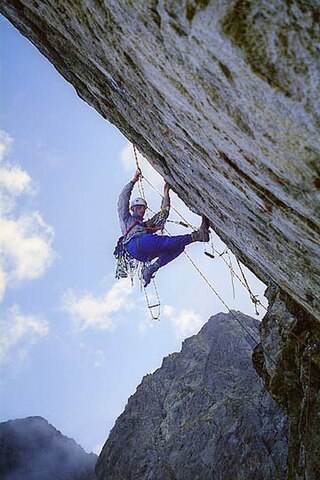
Aid climbing is a form of rock climbing that uses mechanical devices and equipment, such as aiders, for upward momentum. Aid climbing is contrasted with free climbing, which only uses mechanical equipment for protection, but not to assist in upward momentum. Aid climbing can involve hammering in permanent pitons and bolts, into which the aiders are clipped, but there is also 'clean aid climbing' which avoids any hammering, and only uses removable placements.

Royal Robbins was one of the pioneers of American rock climbing. After learning to climb at Tahquitz Rock, he went on to make first ascents of many big wall routes in Yosemite. As an early proponent of boltless, pitonless clean climbing, he, along with Yvon Chouinard, was instrumental in changing the climbing culture of the late 1960s and early 1970s by encouraging the use and preservation of the natural features of the rock. He went on to become a well-known kayaker.

Warren Harding was one of the most accomplished and influential American big wall climbers and aid climbers of the 1950s to 1970s. He was the leader of the first team to climb El Capitan, Yosemite Valley, in 1958. The route they climbed, known as The Nose, ascends 2,900 feet (880 m) up the central buttress of what is one of the largest granite monoliths in the world. Harding made many first ascents in Yosemite, some 28 in all, including The Wall of Early Morning Light.

Jim Bridwell was an American rock climber and mountaineer, active from 1965 in Yosemite Valley, but later in Patagonia and Alaska. He was noted for pushing the standards of both aid climbing and big wall climbing, and later alpine climbing. He wrote numerous articles on climbing and developed several important pieces of aid climbing equipment. Bridwell was an apprentice to Royal Robbins and Warren Harding, and later the unofficial leader of the Stonemasters.
The Fly is a short 25-foot (7.6 m) schist sport climbing or highball bouldering route in the Rumney Rocks climbing area, New Hampshire, USA, at the Waimea Cliff. The Fly was bolted by Mark Sprague in 1995 as an open project but did not see a first free ascent until David Graham, an 18-year-old American climber from Maine, climbed it in April 2000, who graded it 5.14d (9a) or V14 (8B+). It was quickly repeated by his climbing partner, Luke Parady. At the time, these ascents were milestones for climbing in North America.
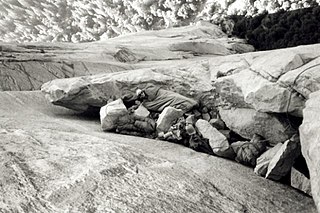
A bivouac shelter or bivvy is any of a variety of improvised camp site or shelter that is usually of a temporary nature, used especially by soldiers or people engaged in backpacking, bikepacking, scouting or mountain climbing. It may often refer to sleeping in the open with a bivouac sack, but it may also refer to a shelter constructed of natural materials like a structure of branches to form a frame, which is then covered with leaves, ferns and similar material for waterproofing and duff for insulation. Modern bivouacs often involve the use of one- or two-person tents but may also be without tents or full cover. In modern mountaineering the nature of the bivouac shelter will depend on the level of preparedness, in particular whether existing camping and outdoor gear may be incorporated into the shelter.

John William Middendorf IV was an American big wall climber, mountaineering writer and designer of climbing equipment.
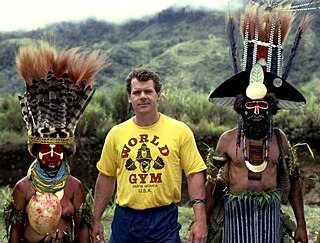
John Long is an American rock climber and author. His stories have been translated into many languages.
Robert John Slater was an American mountaineer known for his first ascent of the big wall route Wyoming Sheep Ranch on El Capitan. An avid outdoor recreationalist, Slater made notable climbs during his college years and later as he worked as a trader on the Chicago Board of Trade and for Goldman Sachs. He died on August 13, 1995, while descending from the summit of K2.
Greg Child is an Australian-born rock climber, mountaineer, author and filmmaker.
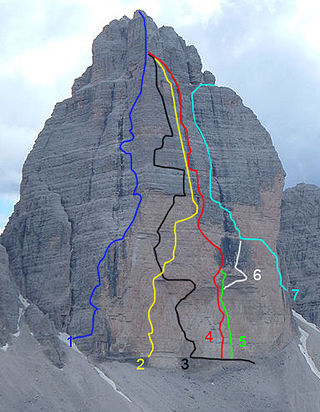
In climbing, a topo is a graphical representation of a climbing route. Topos range from a photograph of the climb on which the line of the route is overlaid, to a detailed diagram of the key features and challenges of the climb, which are typically represented as standardized UIAA topo symbols.
Beth Rodden is an American rock climber known for her ascents of hard single-pitch traditional climbing routes. She was the youngest woman to climb 5.14a (8b+) and is one of the only women in the world to have redpointed a 5.14c (8c+) traditional climbing graded climb. Rodden and fellow climber Tommy Caldwell were partners from 2000 to 2010, during which time they completed the second free ascent of The Nose. In 2008, Rodden made the first ascent of Meltdown, one of the hardest traditional climbs in the world and the first time in history that a female climber matched the peak of the highest climbing grades.

Dean Spaulding Potter was an American free climber, alpinist, BASE jumper, and highliner. He completed many hard first ascents, free solo ascents, speed ascents, and enchainments in Yosemite National Park and Patagonia. He won the Laureus World Action Sportsperson of the Year in 2003. In 2015, he died in a wingsuit flying accident in Yosemite National Park.
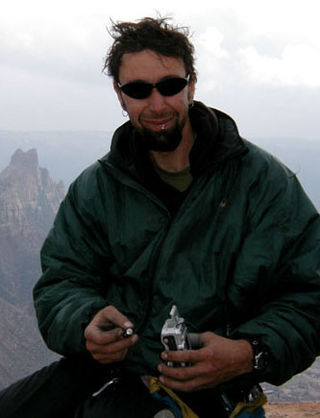
Ammon McNeely was an American rock climber who specialized in big wall climbing and aid climbing, and who set many speed climbing records and made the first "one-day ascent" for many climbing routes on El Capitan in Yosemite. His other interests included BASE jumping and wingsuiting. McNeely was also a slackliner and pioneered many highlines throughout the US.

Big wall climbing is a form of rock climbing that takes place on long and sheer multi-pitch routes that require a full day, if not several days, to ascend. Big wall routes are sustained and exposed and the climbers remain suspended from the continuously sheer and vertical rock face, even sleeping hanging from the face, with limited options to sit down or escape unless they abseil down the route—a complex and risky action. It is therefore a physically and mentally demanding form of climbing.

The Nose is a big wall climbing route up El Capitan. Once considered impossible to climb, El Capitan is now the standard for big wall climbing. It is recognized in the historic climbing text Fifty Classic Climbs of North America and considered a classic around the world.

The Royal Arches Route is a big wall climbing route in California's Yosemite Valley on the Royal Arches wall. The route is recognized in the historic climbing text Fifty Classic Climbs of North America. The route was first climbed Oct. 1936 by Ken Adam, Morgan Harris, K. Kenneth Davis. The route is moderate in difficulty and is frequently climbed. The first 4 pitches are along a west-facing dihedral. At Pitch 5, the route turns north and ascends the main face along crack systems. Pitch 10 can be free climbed at 5.10b however, most climbers use a fixed rope to pendulum to a long ledge. At the end of Pitch 15, begins the bolted rappel route. It is 18 rappels to the Valley floor. Some climbers prefer to continue to "The Jungle" at the end of Pitch 16. Beyond The Jungle is a 5.4 slab and 4th Class scrambling to the Valley Rim. The descent is usually accomplished by traversing northeast to Washington Column and descending the exposed North Dome Gully.

Alex Honnold is an American rock climber best known for his free solo ascents of big walls. Honnold rose to worldwide fame in June 2017 when he became the first person to free solo a full route on El Capitan in Yosemite National Park, a climb described in The New York Times as "one of the great athletic feats of any kind, ever." Honnold also holds the record for the fastest ascent of the "Yosemite Triple Crown", an 18-hour, 50-minute link-up of Mount Watkins, The Nose, and the Regular Northwest Face of Half Dome. In 2015, he won a Piolet d'Or in alpine climbing with Tommy Caldwell for their completion of the enchainment of the Cerro Chaltén Group in Patagonia over 5 days.

Free Solo is a 2018 American documentary film directed by Elizabeth Chai Vasarhelyi and Jimmy Chin that profiles rock climber Alex Honnold on his quest to perform the first-ever free solo climb of a route on El Capitan, in Yosemite National Park in California, in June 2017.





















